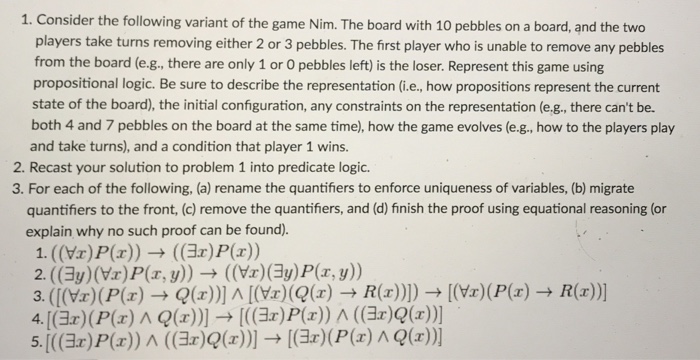Consider the following variant of the game Nim. The board with 10 pebbles on a board, and the two players take turns removing either 2 or 3 pebbles. The first player who Is unable to remove any pebbles from the board (e.g., there are only 1 or 0 pebbles left) is the loser. Represent this game using propositional logic. Be sure to describe the representation (I.e., how propositions represent the current state of the board), the Initial configuration, any constraints on the representation (e.g., there can't be. both 4 and 7 pebbles on the board at the same time), how the game evolves (e.g., how to the players play and take turns), and a condition that player 1 wins. Recast your solution to problem 1 Into predicate logic. For each of the following, rename the quantifiers to enforce uniqueness of variables, migrate quantifiers to the front, remove the quantifiers, and finish the proof using equational reasoning (or explain why no such proof can be found). ((Forall x) P(x)) rightarrow ((x) P(x)) ((y) (Forall x) P(x, y)) rightarrow ((Forall x) (y) P(x, y)) ([(Forall x)(P(x) rightarrow Q(x))]) Lambda [(Forall x) Q(x) rightarrow R(x)]) rightarrow [(Forall x) (P(x) rightarrow R(x))] [(x) (P(x)) Lambda Q(x)] rightarrow [((x) P(x)) Lambda Q(x))] [((x) P(x)) Lambda (x) Q(x))] rightarrow [(x) (P(x) Lambda Q(x))] Consider the following variant of the game Nim. The board with 10 pebbles on a board, and the two players take turns removing either 2 or 3 pebbles. The first player who Is unable to remove any pebbles from the board (e.g., there are only 1 or 0 pebbles left) is the loser. Represent this game using propositional logic. Be sure to describe the representation (I.e., how propositions represent the current state of the board), the Initial configuration, any constraints on the representation (e.g., there can't be. both 4 and 7 pebbles on the board at the same time), how the game evolves (e.g., how to the players play and take turns), and a condition that player 1 wins. Recast your solution to problem 1 Into predicate logic. For each of the following, rename the quantifiers to enforce uniqueness of variables, migrate quantifiers to the front, remove the quantifiers, and finish the proof using equational reasoning (or explain why no such proof can be found). ((Forall x) P(x)) rightarrow ((x) P(x)) ((y) (Forall x) P(x, y)) rightarrow ((Forall x) (y) P(x, y)) ([(Forall x)(P(x) rightarrow Q(x))]) Lambda [(Forall x) Q(x) rightarrow R(x)]) rightarrow [(Forall x) (P(x) rightarrow R(x))] [(x) (P(x)) Lambda Q(x)] rightarrow [((x) P(x)) Lambda Q(x))] [((x) P(x)) Lambda (x) Q(x))] rightarrow [(x) (P(x) Lambda Q(x))]







